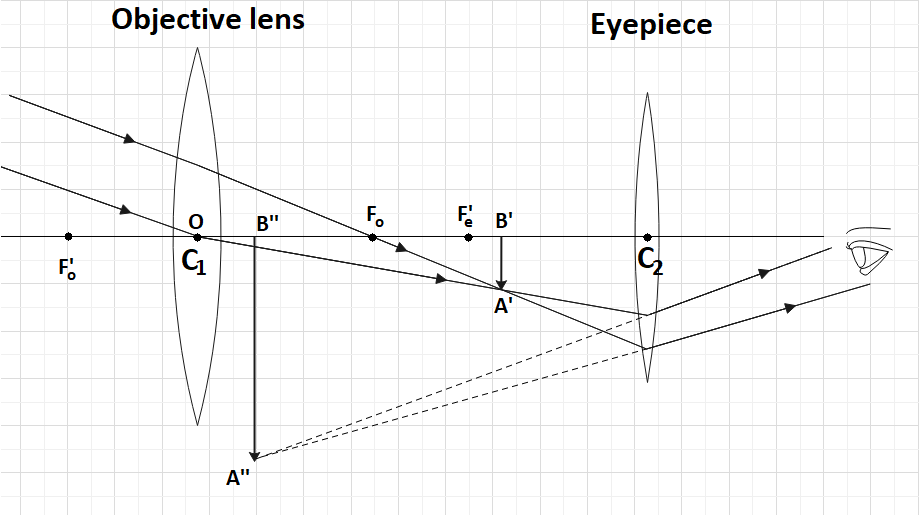
Draw a ray diagram of an astronomical telescope for distance objects in normal adjustment. What is the expression for its magnifying power?
Answer
507.4k+ views
- Hint: Telescope is used to observe objects which are very far from us. Telescopes produce magnified images of distant objects. In a simple telescope two lenses are used, objective lens and eyepiece lens. A parallel beam of light is focused by the objective lens of a telescope and then light passes through an eyepiece forming a magnified image.
Complete step-by-step solution -

Above diagram shows the ray diagram of an astronomical telescope. A parallel beam of light falls on the objective lens of the telescope. Parallel rays are coming from heavenly bodies such as stars, planets or satellites. Since the objective lens is a convex lens, the images $A'B'$ formed are real, inverted, and diminished of the heavenly body. Now the image $A'B'$ acts as an object for the eyepiece $E$, whose position is adjusted so that the image must lie between the optical centre ${{C}_{2}}$ of the eyepiece and the focus $f_{e}^{'}$.
Thus eyepiece $E$ forms a virtual, inverted and highly magnified image of the object at infinity. If the final image of an object is formed at infinity then the telescope is said to be in ‘normal adjustment’.
The above figure shows a ray diagram of an astronomical telescope for distance objects in normal adjustment.
The magnifying power of a telescope is given by
\[M=\dfrac{{{f}_{o}}}{{{f}_{e}}}\]
Where \[{{f}_{o}}\] is the focal length of the objective and \[{{f}_{e}}\] is the focal length of the eyepiece.
Additional Information:
The objective lens focuses the light rays to form a real image of the distant object. This image is formed in the same plane as the principal focus of the objective lens, where the light rays cross each other after passing through the objective lens. The eyepiece gives a magnified view of this real image to the viewer looking through the telescope. This magnified view of the object is a virtual image because it is formed by the rays emerging from the eyepiece that appears to be coming from behind the eyepiece. The virtual image is inverted compared with the distant object.
Note: In order to have a larger magnification of the telescope focal length of the objective should be as large as practically possible and the focal length of the eyepiece should be as small as possible. The image is formed at infinity in normal adjustment. Both lenses should be the converging lens. Image of an object is always inverted with respect to the object formed by an astronomical telescope. We all know that heavenly bodies are usually spherical in shape therefore it does not matter whether the image formed by an astronomical telescope is inverted or not.
Complete step-by-step solution -

Above diagram shows the ray diagram of an astronomical telescope. A parallel beam of light falls on the objective lens of the telescope. Parallel rays are coming from heavenly bodies such as stars, planets or satellites. Since the objective lens is a convex lens, the images $A'B'$ formed are real, inverted, and diminished of the heavenly body. Now the image $A'B'$ acts as an object for the eyepiece $E$, whose position is adjusted so that the image must lie between the optical centre ${{C}_{2}}$ of the eyepiece and the focus $f_{e}^{'}$.
Thus eyepiece $E$ forms a virtual, inverted and highly magnified image of the object at infinity. If the final image of an object is formed at infinity then the telescope is said to be in ‘normal adjustment’.
The above figure shows a ray diagram of an astronomical telescope for distance objects in normal adjustment.
The magnifying power of a telescope is given by
\[M=\dfrac{{{f}_{o}}}{{{f}_{e}}}\]
Where \[{{f}_{o}}\] is the focal length of the objective and \[{{f}_{e}}\] is the focal length of the eyepiece.
Additional Information:
The objective lens focuses the light rays to form a real image of the distant object. This image is formed in the same plane as the principal focus of the objective lens, where the light rays cross each other after passing through the objective lens. The eyepiece gives a magnified view of this real image to the viewer looking through the telescope. This magnified view of the object is a virtual image because it is formed by the rays emerging from the eyepiece that appears to be coming from behind the eyepiece. The virtual image is inverted compared with the distant object.
Note: In order to have a larger magnification of the telescope focal length of the objective should be as large as practically possible and the focal length of the eyepiece should be as small as possible. The image is formed at infinity in normal adjustment. Both lenses should be the converging lens. Image of an object is always inverted with respect to the object formed by an astronomical telescope. We all know that heavenly bodies are usually spherical in shape therefore it does not matter whether the image formed by an astronomical telescope is inverted or not.
Recently Updated Pages
Master Class 12 Business Studies: Engaging Questions & Answers for Success

Master Class 12 Economics: Engaging Questions & Answers for Success

Master Class 12 English: Engaging Questions & Answers for Success

Master Class 12 Maths: Engaging Questions & Answers for Success

Master Class 12 Social Science: Engaging Questions & Answers for Success

Master Class 12 Chemistry: Engaging Questions & Answers for Success

Trending doubts
What are the major means of transport Explain each class 12 social science CBSE

Which are the Top 10 Largest Countries of the World?

Draw a labelled sketch of the human eye class 12 physics CBSE

How much time does it take to bleed after eating p class 12 biology CBSE

Explain sex determination in humans with line diag class 12 biology CBSE

Differentiate between homogeneous and heterogeneous class 12 chemistry CBSE




